Oliver he/him visual librarian
Last active 60 minutes ago
Don't wanna be here? Send us removal request.
Text

Clay loom weight decorated with an owl, Greek, 5th Century BCE
From the Acropolis Museum
6K notes
·
View notes
Text

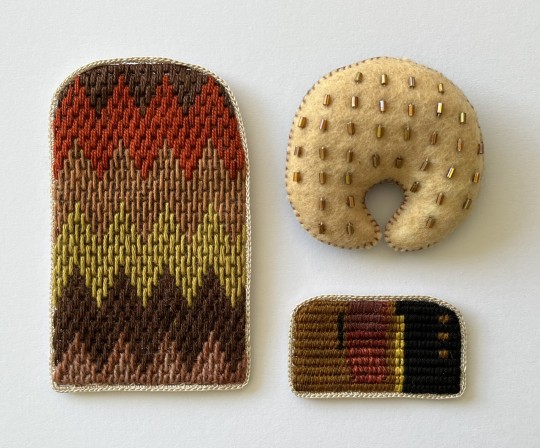


Some more arrangements.
Just having fun really, none of these can be stitched down. But I like playing, seeing how things relate.
425 notes
·
View notes
Text
Okay, I did not expect that video I posted to blow up like it did. Thanks everyone!
There were several people who asked about any books I'd recommend. The following two books were the ones that I learned a majority of my patterns from.
Book #1

More below the cut.
This was the first book I had that my mom got me when I was 11. The directions are clear, easy to follow, and the added illustrations were a huge help. This was where I learned my base 5 patterns; Diagonal,

Chevron,

Diamond,

Lightning,

and Arrowhead.

I didn't learn the more advanced patterns until much later, with the next book.
Book #2

I didn't get this book until my early 20's. It also had clear directions with illustrations and graphs of the patterns to help with the learning process. This was where I learned the more complicated patterns like the Acadian,

Assomption,

and Flame patterns.

I'd recommend these two books for anyone starting out with fingerweaving. I wouldn't be at the skill level I'm at without them.
Anyways, I hope this helps anyone looking to start learning!
287 notes
·
View notes
Text
smolweaving resources
a masterpost of resources to complement that post going around the other day with a glossary of several different kinds of small weaving. design your own potholder loom squares: https://friendlyloom.com/pages/potholder-design-wizard
make a pin loom: https://windsweptmind.com/2016/07/04/adventures-in-pin-loom-making-and-so-can-you/
warp a pin loom the regular way: https://adventuresinpinloomweaving.com/2018/09/21/choose-your-warping-method/
the diagonal way: https://howdidyoumakethis.com/square-pin-loom-speed-weaving/
fingerweaving
how-to: https://www.metismuseum.ca/fingerweaving/
another how-to: https://nativetech.org/finger/beltinstr.html
additional resources: https://jumaka.com/2019/03/finger-weaving/
tablet weaving
how-to: https://www.shelaghlewins.com/tablet_weaving/TW01/TW01.htm
another how-to: https://jumaka.com/2019/02/card-weaving/
personal favorite site for designing tablet weaving drafts: https://twistedthreads.org/
backstrap rigid heddle weaving
how-to: https://spinoffmagazine.com/backstrap-rigid-heddle-basics-get-weaving-handspun-bands/
3D printed rigid heddle backstrap loom parts:
https://www.thingiverse.com/thing:6141824
3D printed rigid heddles for band weaving:
https://www.thingiverse.com/thing:3999858
inkle loom weaving
how to build a loom from pvc and get started: https://littlelooms.com/a-free-guide-to-inkle-weaving/
inkle loom/rigid heddle backstrap pattern design: https://carolingianrealm.blog/PatternGenerator.php
574 notes
·
View notes
Text
Low space & low budget weaving
Want to weave but don't have space for a loom? Have a few sticks and yarns but no DIY skills? Come, be tempted anyway. Weaving is a whole family of crafts, some of which don't require a loom at all.
Small-ish looms like box looms (as basic as yarn wrapped around a cardboard grocery tray), inkle looms, and rigid heddle looms exist, but I'm assuming every possible space for a box in your life is already filled. In this post we're going even smaller and cheaper. As far as possible, everything either is flat enough to stow behind/under furniture or rolls up safely into a bundle of just sticks and yarn.
Many of these crafts have some crossover - the same setup can be used for multiple styles of weaving. Most of them can be improvised at home depending on what you have on hand, or if you need to buy something there is not a huge gulf between homemade vs professional equipment. Alas I am not skilled in any of these and my descriptions will not be wholly accurate; corrections and additions welcome! If you need help, I'd only be able to tell you to seek out books and tutorials yourself, ask other weavers, and just try stuff out.
All photos included with permission. My thanks to the people allowing me to use their projects! I saw so many gorgeous and skillful projects when assembling this and I wish I could have included them all.
Fingerweaving
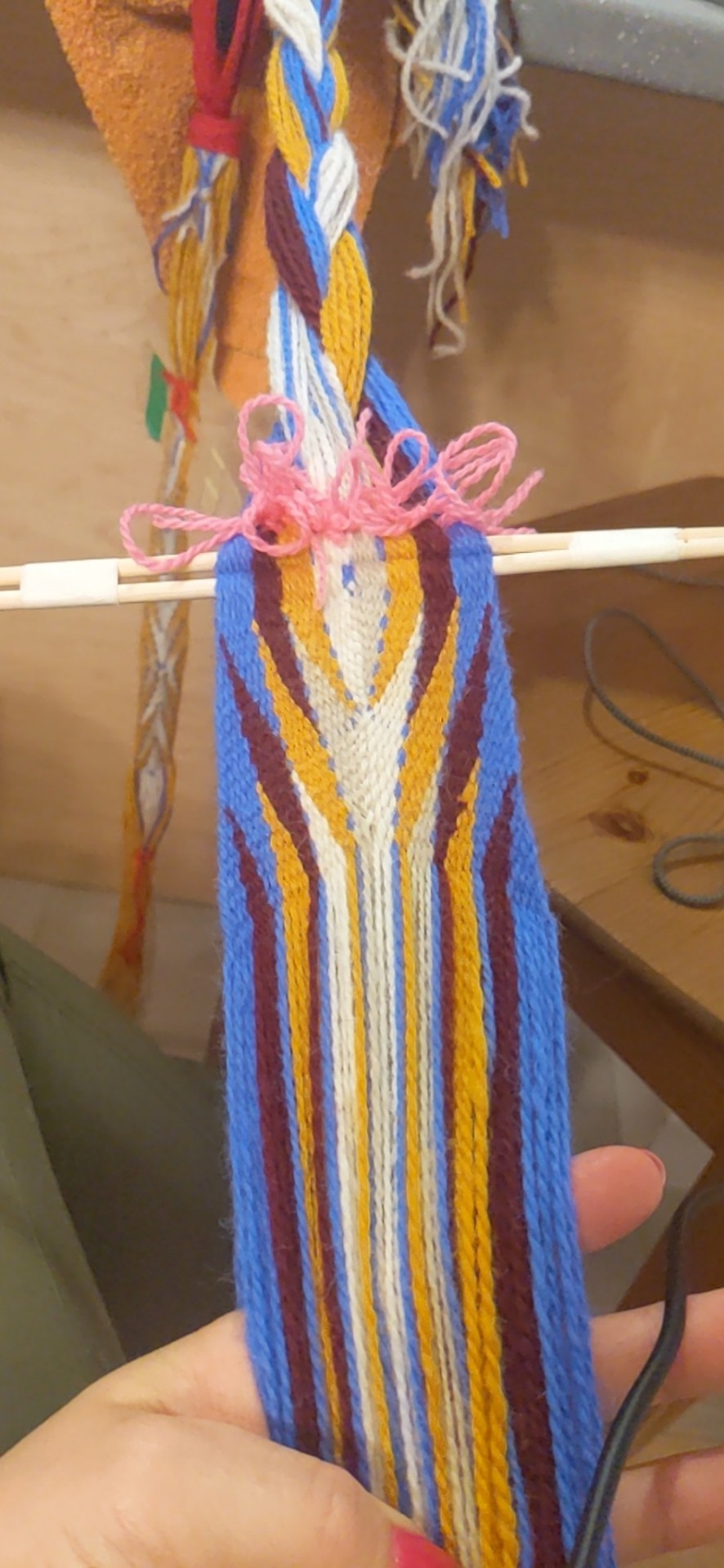

Projects by @kitteniestkitten (here) and @wefty-weaver (here)
Culture - I am aware of this as a Native American technique, I don't know its history with any more specific tribe.
Fabric - "Warp faced" cloth of any width, insofar as warp and weft have meaning for this craft as the weaving is on a diagonal. Often used for sashes or blankets.
Method - There is no loom! A couple sticks hold the yarns to begin with, but then it is all freehand. Starting at one corner, you use your fingers to weave a strand through the other strands, and... that's it. Very simple beginnings work up to very complex patterns that no loom is capable of. The whole project can be rolled up when not active.
Backstrap loom

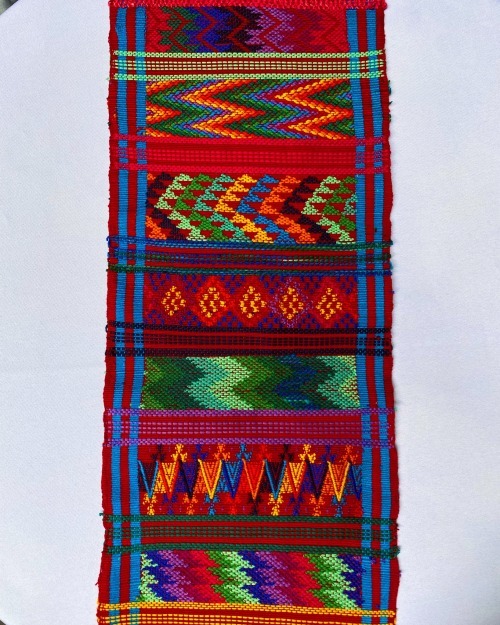
Projects by @calendae-creations (here) and @weavingforlooms (here)
Culture - I am most aware of this from the Andes but I think it is much more widespread than that.
Fabric - Warp faced or balanced fabric of any width up to your own reach, suitable for blankets and clothes and many other things.
Method - You are the loom! Several horizontal rods hold and manipulate the warp threads but your body provides the tension, with the other end hooked to some furniture or around your own feet. When not in use, you can roll up all the equipment into a small bundle of yarn and rods. You can also use a backstrap loom setup for other methods like tablet weaving.
Warp weighted loom

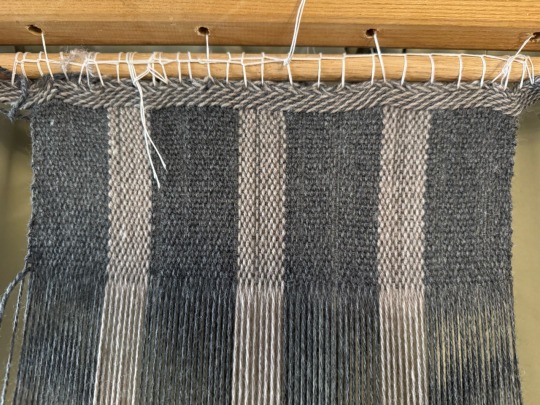
Projects by @shadowcreepling (here) and @doctormead (here)
Culture - used by ancient Greeks among many many others.
Fabric - any kind of fabric at any size. Shadowcreepling is using a warp weighted loom for a tablet-woven band, Doctormead is probably using heddle rods to make a wider piece of cloth.
Method - the warp threads are held by a bar at the top and tensioned with weights on one end that hang down towards the floor, then the weft is woven into them with any method such as tablets, heddle rods, or by hand (if you have a lot of patience) and beaten into firm fabric at the top or bottom of the loom. Warp weighted looms can be very big, but they are simple and can also be very small and taken apart when not actively weaving.
Tablet weaving / card weaving


Projects by @damage-ko (here) and @foxease (here, hardware from CellesKit on Etsy)
Culture - found as far apart as textiles (geographically and temporally) from Byzantine Egypt and the Vikings
Fabric - a warp faced fabric with patterns made by twining warp threads around each other, usually used for strong narrow bands like collars, belts, and shoelaces.
Method - the cards hold open the shed so you can pass the weft through, then rotate the cards to advance the pattern. Many people make their own with cardboard or playing cards, or you can buy some. The rest of the weaving setup can be improvised with a backstrap (or just a shower curtain hook clipped to your trousers), a cardboard box loom, or warp weights.
Rigid heddle band weaving


Projects by @pisaracraft (here) and @crookedtines (here)
Culture - small rigid heddles like the first project have been found in Roman archaeological sites across Europe. The larger rigid heddle in the second project is being used for "baltic pickup" style designs on the band.
Fabric - can be warp faced or a balanced weave, size limited by the size of your heddle.
Method - you provide tension with any setup you please such as an inkle loom, backstrap, or warp weights. The heddle creates sheds so that you can pass weft yarn through the warp easily. Infinitely many "pick-up patterns" let you weave patterns and even words into the cloth.
Pin loom / potholder loom
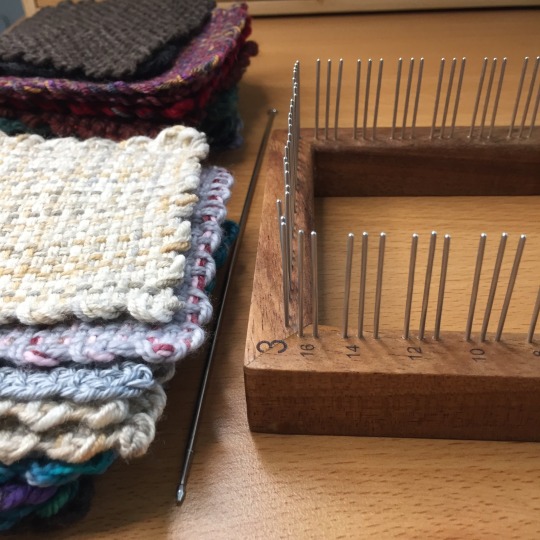

Projects by @pardalote (here) and @weavingmyheartout (here)
Fabric - a small square (or rectangle or triangle) of balanced weaving, which can be used alone or patched together into larger fabrics. Pin looms are finer and suitable for many knitting/crochet yarns, potholer looms are chunkier and designed for big elastics, but the method is similar.
Method - wind yarn lengthways around one set of pins and then pull yarn widthways through these strands with a hook. Or, work at 45 degrees in continuous strand weaving! Lots of room to experiment with colour and texture. You can improvise a pin loom by cutting notches in a square of sturdy cardboard.
Needle weaving / stick weaving / peg loom
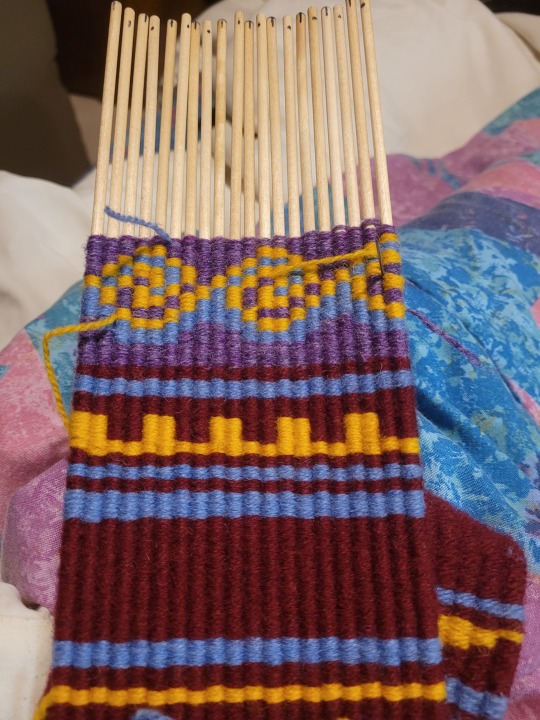

Projects by @thaylepo (here) and @pastelispunx (here)
Fabric - weft-faced fabric and rugs of any size.
Method - thread long thin warp threads through the pegs, then wind a thick weft (eg heavier yarn, sheep fleece, or long scraps of fabric) around the pegs. Push the weft down along the pegs as they fill up, so that it slides off onto the warp. The pegs can be secured in a base to make a peg loom for large projects, or just handled freely. I believe these evolved as separate crafts and the nuances are different, but the overall method is similar.
Frame loom / tapestry loom


Projects by @squeakygeeky (here) and @battlestar-gasmacktica (here)
Fabric - weft-faced or balanced fabric ideal for wall hangings and upholstery, size limited to the frame being used.
Method - (usually) thinner warp threads are wound round a frame, such as heavy cardboard with notches cut in the end, a picture frame, or a small and flat purpose-made loom. Thicker weft threads are woven in by hand using needles or just small lengths of yarn. Some people make lifelike images, others make more ordinary fabrics or geometric patterns.
Bobbin lace
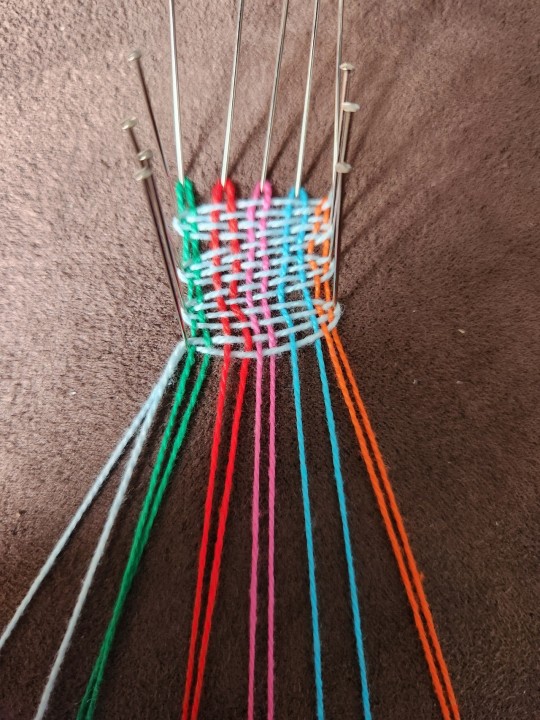
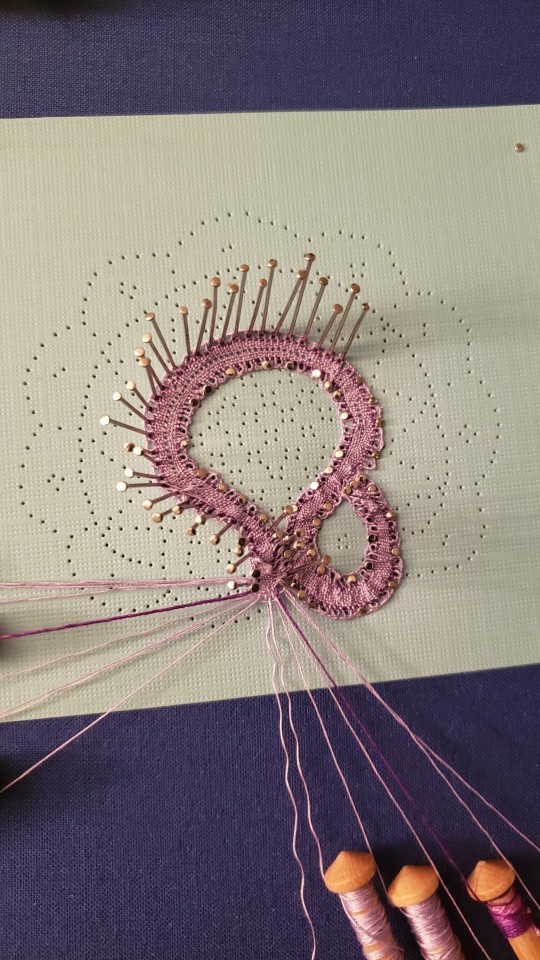
Projects by @crochetpiece (here) and @noxx-notions (here)
Culture - began in renaissance Italy and spread throughout Europe, often as a cottage industry.
Fabric - balanced fabric usually made of very thin threads in freeform shapes. It's not usually considered "weaving" but the basic cloth stitch is definitely a woven fabric!
Method - each thread is wound onto a bobbin (e.g. a clothespeg) and then bobbins are crossed over each other to weave threads together. The lace is pinned to a cushion to hold everything in place while the design grows.
4K notes
·
View notes
Text

Une ile, 2025, 30x40 cm
Graphite, aquarelle
[an island, 2025]
18 notes
·
View notes
Text

Richard Serra: Solids, (adv. in «Artforum» magazine), Gagosian, New York, NY, November 4 – December 20, 2008 [Art Books & Ephemera. © Richard Serra / ARS, New York]
33 notes
·
View notes
Photo





















Marathi poet Narayan Surve (1926-2010) recites his poem “Karl Marx” in Saacha, The Loom (2001).
996 notes
·
View notes
Text



Suite des carnets de Mai 25. Serge p. Monotypes 20X30.
22 notes
·
View notes
Text
HUgE Feb 2013
Shingo Wakagi's Photo Monologue
Page: 10
2012, Winter in Kisarazu
Young Tree diary
I'm rude but delicate.

I am often asked about my bookstore. Why? Why do people ask such questions? But I have to prepare an answer. If I said "I just wanted to try it," it would be seen as just a game. I am certainly trying to play seriously. Play means having your own rules. You can't follow the rules of profit-making. So is this an activity? There are many ways to say it, such as contributing to the local area, giving back, or revitalizing the town. If you say it out loud, you will be held responsible. I don't want to say it myself. In the first place, can a bookstore that specializes in photo books develop the local area? It's just one more luxurious store to waste money on the shopping district of a town with a poor economy. Even so, the staff at the store work very hard. I can't thank them enough. I'm sure they all have their own thoughts, but it's no exaggeration to say that they are friends who join me in my serious play. There's no need to spill my feelings just because I'm writing a diary, but the truth is, I don't have any plans. Even if I did, it wouldn't be a business plan, it would be a plan for the next game.
The other day, I went to scout locations for work and found a stuffed polar bear. I'm sure there are countless people who have looked at it and blurted out, "Why?" When I reached the top of the stairs leading to the second floor hall of the local civic center, there it was, waiting for me, with its tail towards me. It was posing as if it was roaring with all its might, but it was displayed apologetically in the corner of the banister in the atrium. Still, there was nothing around it, so it looked like it had the clear space all to itself. It was a sign of friendship for the city.
Or, a local shipping company has donated a billboard to turn a polar bear into a 3D logo sign.
You can see their enthusiasm. Moreover, the area is surrounded by poles and ropes for floor guides, and a sign from the director reads, "Please do not enter, it is dangerous." There is a sense of incongruity there, which is no longer a joke or seriousness. Above all, the polar bear himself is probably wondering the most: "Why am I here?" He is not stuffed and goes to the museum, and even though he does not bite, he is labeled as "dangerous" (it would be better if he was told "I am delicate, so please do not touch me"), and he provides a topic of conversation for the local people who have come to the enka recital, comedy show, and other events while they are waiting. "Why?" But children are probably different. They don't care about the reason, and they will accept the polar bear's presence without any hesitation, and they will think various things, such as "I didn't know polar bears were so big, they are not white as expected, and their noses look like pigs. While the mothers are gossiping about the neighborhood, they are probably imagining how they would like to ride on the polar bear's back, or how one day it will speak to them in human language. I want you to imagine. I want the thing that fills the stuffed animal, from which both flesh and soul have been removed, to be your imagination, not the word "why?". Ah, I have never felt such sympathy for a human before.
Rolling Stone
Just as Zu felt sympathy for the devil, I feel pity for the stuffed polar bear.
*Shingo Wakagi is a photographer and film director. He was born on March 26, 1971 in Hamamatsu, Shizuoka Prefecture. After graduating from the Department of Photography at the Rochester Institute of Technology in New York, he became active as a photographer in a wide range of fields. His first film as a director was "Starlight Waltz".
He was nominated for the Tiger Award at the Rotterdam International Film Festival and the Newcomer Award at the Chicago International Film Festival in 2008. In 2009, he released his second film, "Totem Song for Home." He also founded his own publishing company, Young Tree Press, and opened a bookstore, "BOOKS AND PRINTS," in his hometown of Hamamatsu, Shizuoka Prefecture, in April 2010. On October 10, 2012, he opened the second store, "BOOKS AND PRINTS-BLUE EAST."*
5 notes
·
View notes
Text

Helmet, Meantime, (Vinyl/LP), 7567-92162-1, Interscope Records / Amphetamine Reptile Records, 1992 [Covet The Cover]





Design: Reiner Design Consultants Photography: David Plowden
41 notes
·
View notes
Text





Cho Giseok: Mathiieu Simoneau for Numero Magazine, 2023
458 notes
·
View notes
Text

Corky Lee (photograph), Yuri Kochiyama [takes a stand in the streets of New York City's Chinatown neighborhood to defend the rights of Silver Palace restaurant workers], (gelatin silver print), 1980, Printed 2016 [National Portrait Gallery, Smithsonian Institution, Washington, DC. © Corky Lee Estate]
Plus: Alice George, Behind This Photo Is the Story of Two Asian American Folk Heroes, Smithsonian Magazine, May 20, 2021
48 notes
·
View notes



